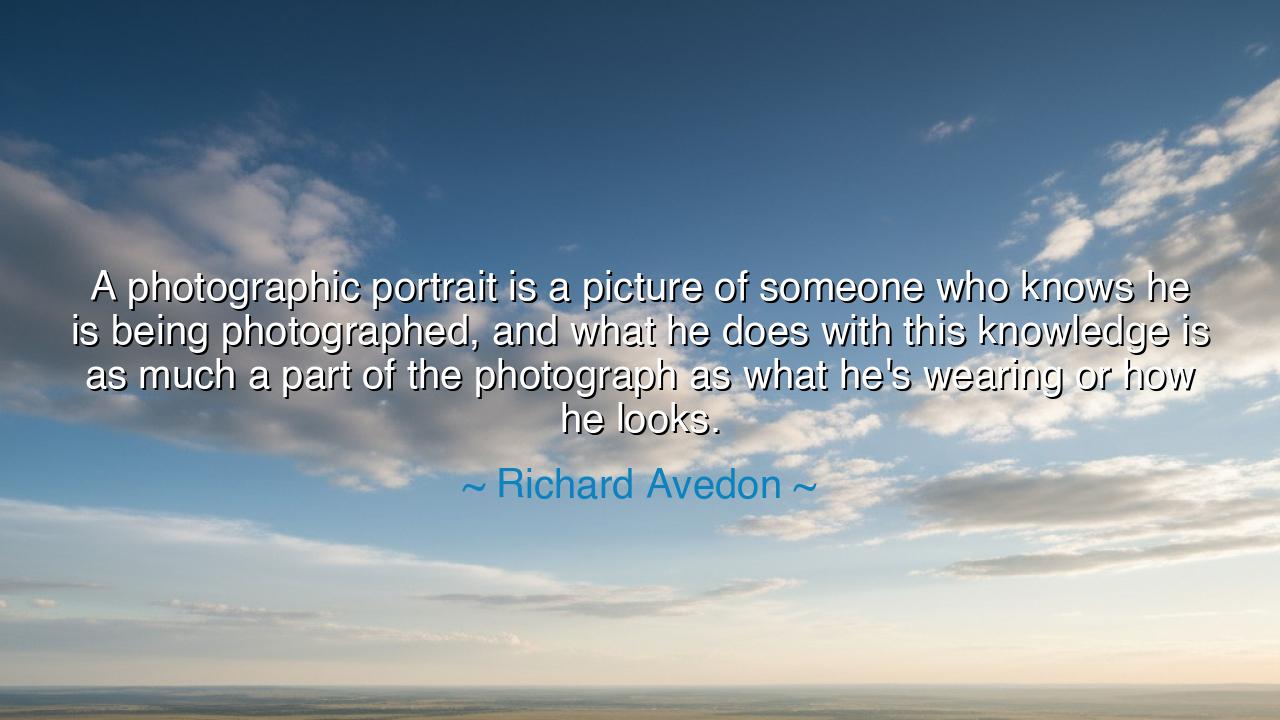
A photographic portrait is a picture of someone who knows he is
A photographic portrait is a picture of someone who knows he is being photographed, and what he does with this knowledge is as much a part of the photograph as what he's wearing or how he looks.






Hear the words of Richard Avedon, master of the lens, who declared: “A photographic portrait is a picture of someone who knows he is being photographed, and what he does with this knowledge is as much a part of the photograph as what he’s wearing or how he looks.” In this insight, he reveals that the portrait is never merely a mirror, but a dialogue between subject and camera, between the inner awareness of the one observed and the outer frame that captures them. A photograph is not only flesh and fabric; it is consciousness made visible.
For when a man or woman stands before the camera, they are not as they were in solitude. The very act of being seen transforms them. Some harden into masks, summoning dignity or strength. Others soften, exposing vulnerability. Some attempt to deceive, projecting confidence or joy, while others surrender to truth, allowing sorrow or fatigue to shine through. Thus, knowledge of being photographed becomes a living thread in the portrait, weaving itself into the image as surely as light and shadow.
Avedon himself proved this in his art. When he photographed the powerful—presidents, kings, and generals—their awareness of the camera often magnified their pride. But when he captured the forgotten—the drifters, the workers, the weary of the American West—their gaze held another kind of awareness, one stripped of pretense, raw with humanity. The knowledge of being seen gave each portrait its character, turning the image into a testimony of the soul as much as of the body.
History offers us an echo of this truth even before the camera’s invention. Consider the painted portraits of royal courts. When monarchs sat for their likeness, they posed not merely to reveal their features, but to project power, authority, or sanctity. They held symbols in their hands—scepters, globes, swords—not because those were part of their daily life, but because they knew the portrait would shape how generations remembered them. Their awareness of being portrayed was inseparable from the meaning of the portrait itself.
This truth is not confined to kings or to models. It belongs to all. Every photograph of a child smiling, of a family gathered, of a stranger caught in an unguarded glance, reveals this eternal interplay: the awareness of being seen, the silent decision of how to appear. In that moment, we are authors of our own image, even when we do not know it. And the camera preserves not only our likeness but our response to being observed.
The lesson is clear: photographs do not lie, but they do not tell the whole truth either. They reveal the body, yes, but also the consciousness of being seen. They teach us that what we project outward shapes not only how others perceive us, but how history will remember us. Thus, we must live with the awareness that every act, every look, every choice becomes part of the portrait we leave behind, whether captured on film or etched in memory.
So I say unto you: live as if the lens is always upon you. Not in fear, not in vanity, but in integrity. Let your awareness of being seen awaken you to authenticity, so that when the moment is preserved—whether in a photograph, a story, or the memory of those around you—it will reveal not a mask, but your truest self. For as Richard Avedon declared, the portrait is not only how you look, but what you do with the knowledge that you are seen.
Thus his words endure as wisdom: every portrait is a meeting of gaze and consciousness, a revelation of self-awareness made eternal. To live well, then, is to live truthfully, for the world itself is the great camera, and every moment is part of the portrait of your life.






AAdministratorAdministrator
Welcome, honored guests. Please leave a comment, we will respond soon